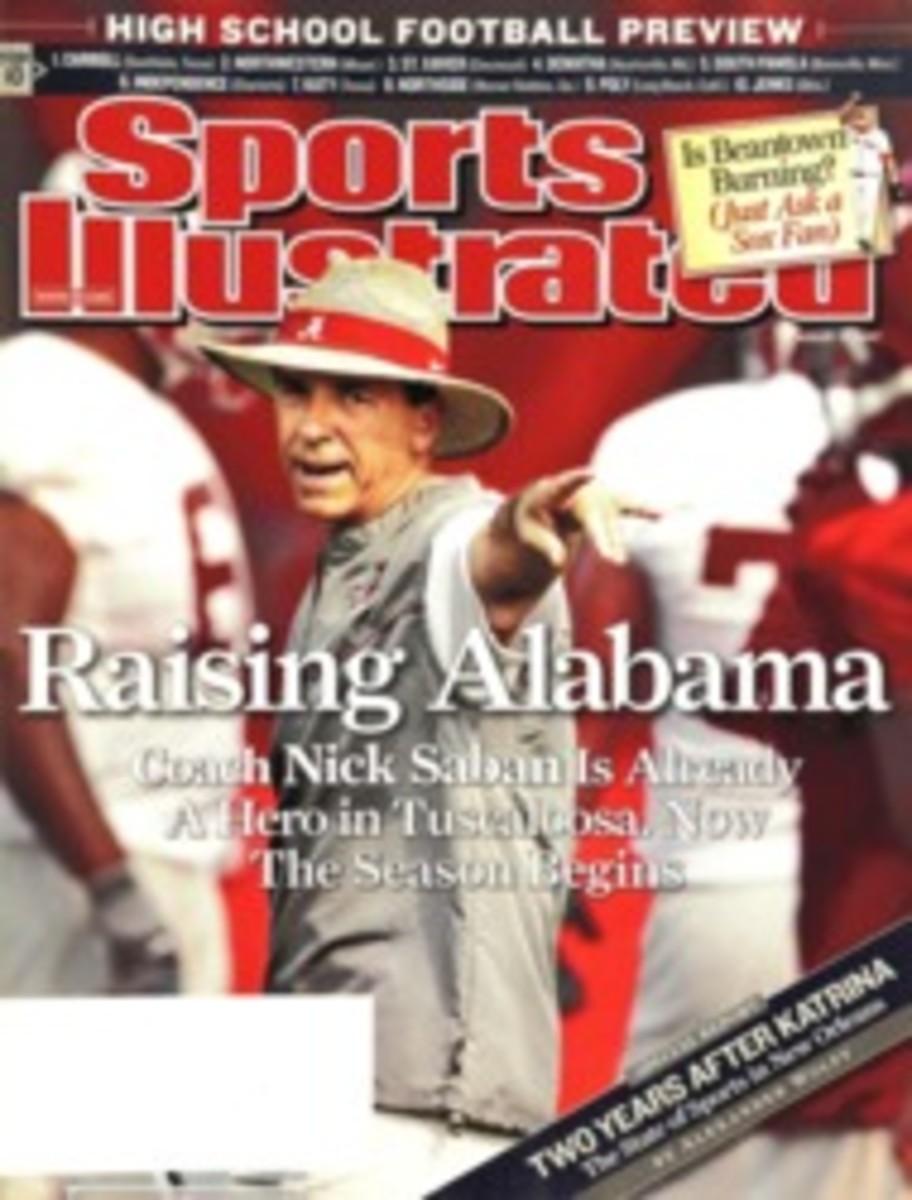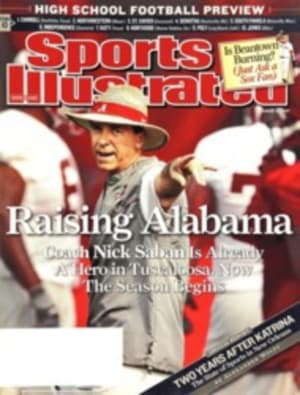
Courtly Rivals
The kid assumed hewas being punk'd. After a fine freshman season as Florida's No. 1 singlesplayer, Jesse Levine was luxuriating at home in Boca Raton last month when hiscellphone chirped. An IMG agent was calling in search of a practice partner forRoger Federer, a few days removed from winning Wimbledon for the fifth straighttime. Would Levine meet Federer at his training base in the United ArabEmirates? "When I realized it wasn't a joke," says Levine, "I waslike, 'Yup. That works for me.' " ¶ Levine spent 10 days in Dubai hittingtennis balls with the greatest player on Earth and eating lavish meals andrelaxing in a swank hotel. "It was pretty sweet," he says.
Why would Federerfly a college kid halfway around the world to train with him? While it wasnever explicitly stated, Levine knew damn well why. He's a lefthander and thuscould simulate the play of No. 2-ranked Rafael Nadal.
So it goes whenyou're embroiled in a rivalry. At the U.S. Open, which begins in New York Cityon Monday, Federer and Nadal will be on opposite poles of the draw. Yet if formholds--as it has at the last two Grand Slam championships--the two men will bedrawn to each other like magnets and will come together on the final Sunday.Serbia's Novak Djokovic has made inroads recently, beating both Nadal andFederer at the Rogers Cup in Montreal, but otherwise the world's top twoplayers have simply hijacked the men's game. One or the other has won the last10 Grand Slam titles and 21 of the last 28 Masters Series tournaments. In theprocess they have fashioned what may well be the most gripping rivalry in allof sports.
Federer-Nadal(Roger-Rafa to everyone in the Kingdom of Tennis) meets all the prerequisiteswe usually set for a rivalry. There are clashing games, divergentpersonalities, swings in momentum. In tennis as in boxing, styles make fights.Federer, a righty, is an artist, capable of executing any shot in the book--andmany that aren't. He's so smooth that he sometimes seems too proud to use merepower to win a point. Nadal, a lefty, plays violent tennis, pounding the balland at the same time lacing it with so much spin that his ground strokes tendto bounce like kick serves. Other players uniformly refer to him as "abeast," but they mean it as a compliment.
By virtue of theirconsistent winning, Federer and Nadal meet often--another requirement of athriving rivalry. Since 2004 they've faced off 13 times, only one fewer thanBjorn Borg and John McEnroe, the men's tennis rivals against which all othersare measured. What's more, the Roger-Rafa dividing lines have recently blurred.At first the duo seemed to have reached a détente in which Nadal ruled the clayand Federer lorded over every other surface. But in May, Federer snappedNadal's streak of 81 straight clay-court wins and then made him sweat in theFrench Open final. Returning the favor, Nadal pushed Federer to a fifth set onthe latter's choice surface, grass, in a spellbinding Wimbledon final. "Heputs me under immense pressure whenever and wherever we play," saysFederer. "But I do the same for him."
The contrast intheir personalities isn't quite as stark as the fire of McEnroe versus the iceof Borg, but Federer and Nadal do have disparate personas. Federer, 26, is aworldly polyglot who just filmed a segment with the PBS talk-show host CharlieRose. Nadal, 21, is a quintessential jock whose idea of formality is removinghis sweat-saturated bandanna. At the Wimbledon final, after they met at the netfor the coin toss, Nadal sprinted to the baseline, recalling Pete Rose dashingto first base after drawing a walk, while Federer went over to his chair andmeticulously removed the cream-colored blazer he had worn onto CentreCourt.
Further amplifyingtheir rivalry: You can pull up a stool and stay past last call debating theirrespective merits. The Swiss Mister has won 11 majors to Nadal's three. He'sthe more complete player. He has held the ATP's No. 1 ranking since early 2004and next week will eclipse Steffi Graf's record of 186 straight weeks in therankings penthouse. Yet the Rafaelites will counter that the Spaniard leadsFederer in head-to-head meetings 8-5 and has amassed more rankings points thanFederer in '07. Nadal's winning percentage in tournament finals, 82.1, is thebest in the Open Era, suggesting unparalleled mental toughness. (Federer's is75.4.) And though Nadal has fewer major titles, he has more than Federer had atage 21.
Don't, however,expect Federer or Nadal to join the discussion. And here's where their rivalryis different from most: There's not a trace of animosity in it. Each man isrelentlessly deferential toward the other, dispensing more props than aBroadway stagehand. Says Nadal, "To me he is the best player." SaysFederer, "Trust me. I know how good Rafa is."
Hear them gush likethis and it becomes apparent that they're not so opposite after all. They wereboth raised in traditional European families that regard ego as a majorcharacter defect. Federer's modesty is as characteristic as his silkenbackhand. (He spent part of his last Christmas break visiting an orphanage inIndia.) But Nadal's no prima donna either. At the French Open the two-timedefending champ was spotted sweeping the clay courts when he was donepracticing. "We're no better than anyone else," says his uncle andcoach, Toni Nadal.
Classic rivalsChris Evert and Martina Navratilova became fast friends. Once, before they metin a Grand Slam final, one of them had her period, and together they scouredthe locker room for a tampon. While Federer and Nadal aren't quite at thatpoint yet (and not simply because neither menstruates), unmistakable warmthpasses between them. When they crossed paths last week in the locker room ofthe Cincinnati event, they casually slapped five. It might as well have been asecret handshake. They are acutely aware that they're members of an exclusiveclub, that each benefits from having the other around. "He pushes me to bebetter," says Nadal. "I think every [athlete] needs that."
In May, Federerventured to Nadal's home island of Mallorca to play an exhibition on a courtthat was half grass and half clay. Federer noted that Nadal had played in hishometown, Basel, before. "Now," he said, "I have the opportunity toplay at his place." Earlier this month, after the Rogers Cup, Nadal wasunable to get a flight out to the next tour stop, in Cincinnati, so Federerinvited him to ride in his private plane.
It all makes forstrange times for tennis fans. Rivalries tend to cleave public opinion. Who inhis right mind roots for North Carolina and Duke, for the Yankees and the RedSox, for Hillary and Rudy? These deep divisions give the matchups emotionaltexture. Yet in the case of Federer-Nadal, it seems entirely reasonable tocheer for both. In fact, for most of us, it feels forced to summon dislike foreither.
Though recenthistory suggests that Federer-Nadal XIV will take place at the U.S. Open finalon Sept. 9, it's no sure thing. Federer is the three-time defending Open champ,but Nadal has never been beyond the tournament's quarterfinals and issusceptible to being outhit on hard courts--all the more so given his recentwrist and knee injuries. Their hegemony is also being challenged by thethird-ranked Djokovic. In fact, if the 20-year-old Serb keeps improving at hisrecent pace, we'll have this to ponder: Is there such a thing as atri-valry?
"He puts me under IMMENSE PRESSURE whenever and wherever we play,"Federer says.  "But I do the same for him."
MORE
Ask Jon
Submit your U.S. Open questions to Jon Wertheimthroughout the tournament.
ONLY AT SI.COM
TWO PHOTOS
RON C. ANGLE/BEIMAGES; Photograph by Ella Ling/BEImages Sports
 BlueStreaks
The last 10 Grand Slam men's singles titles have been won by either the elegantFederer (right) or the bruising Nadal.
PHOTO
TOBY MELVILLE/REUTERS
 HUG ITOUT
After their gripping five-set Wimbledon final, the exhausted rivalscongratulated each other warmly.

